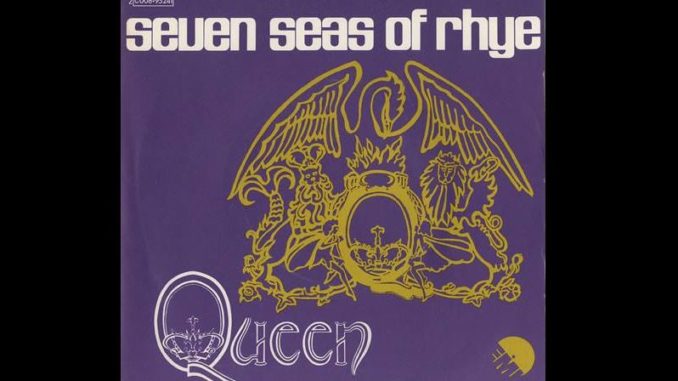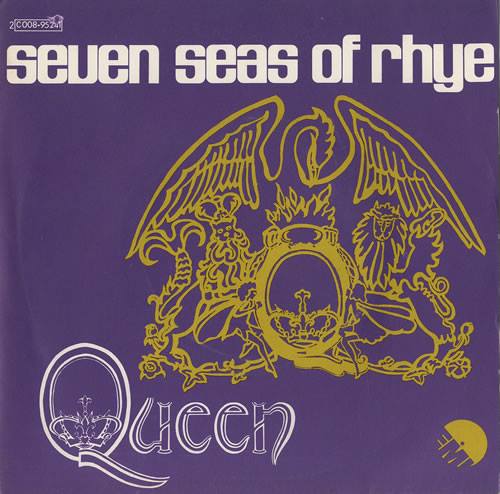
The song Seven Seas of Rhye by Queen has a fascinating story. We were first introduced to the track as a short, rudimentary instrumental version, tucked away at the end of the group’s debut album Queen (1973). Later we got a fully realised, definitive version on Queen II (1974).
Even though the finalised version is over twice the length of the original, it is still a relatively short song (being only 2:47 long to the first version’s 1:15).
The song had only been half-written at the time of recording for Queen’s first album – or to put it more accurately: at first it wasn’t thought of as anything more than an instrumental musical sketch, perfect for closing out their first album.
Freddie Mercury had a weak spot for the piano theme, though, and kept tinkering with it, as he would keep doing for other pieces of music. The song grew, started taking shape, got lyrics, and when it was finished it had ended up a bit different and much more complete from what Mercury first envisioned.
Seven Seas of Rhye was primarily written by Freddie Mercury, with Brian May contributing the second middle-eight featuring his trademark guitar orchestration. The song is officially credited to Mercury only.
Brian said: “The song was Freddie’s idea. He had this lovely little riff idea on the piano. All the middle-eight is however stuff that I did, so we definitely worked on it together. But when it came to the album coming out, Freddie went “I wrote that.” And we all went, “…okay!” It didn’t seem like that big a deal, but Freddie said, “I wrote the words and it was my idea so it is my song.” The unwritten law was that the person who brought the song in would get the credit for writing that song. And, the money for writing that song. Much much later in Queen’s history we [changed this].”
The song features a distinctive arpeggiated piano introduction. On the Queen II recording, the arpeggios are played with both the right and left hands, an octave apart, whereas on the Queen recording, and most live performances, Mercury played the simpler one-handed version of these arpeggios. These piano runs are sampled for the end of It’s a Beautiful Day (reprise) on the album Made in Heaven.
The way the song ends on the Queen II version has always been a topic of conversation. It ends with a cross fade, instruments blending into the band singing “I Do Like To Be Beside the Seaside“, accompanied by a stylophone played by producer Roy Thomas Baker. This gives an interesting link to the next album, Sheer Heart Attack (1975), where the opening track Brighton Rock briefly mirrors the outro of the previous album through the whistling during the first few seconds. The use of stylophone was also the sole exception to their “no synths” rule until 1980 and the release of the album The Game.
Mercury never spoke much about the lyrics of the song. In a 1977 radio interview, he simply described them as a “figment of his imagination” without going into details. The observant fan will however note that the song, like many of the songs on the album (and on the Queen and Sheer Heart Attack albums) refers to a fantasy world named Rhye and fantasy-themed events taking place there. One such example can be found in the song Lily of the Valley from the Sheer Heart Attack album: “Messenger from Seven Seas has flown, To tell the king of Rhye he’s lost his throne.”

This final version would become the band’s third single, released on 23 February 1974. It would also be the band’s first hit due to an unexpected opportunity.
The song was originally meant to be an album track on Queen II, when a sudden opportunity presented itself. David Bowie had to cancel an appearance on Top of the Pops. He was due to perform Rebel Rebel for the 21 February edition, and his late cancellation prompted frantic phone calls from the BBC to the labels. Who could possibly fill in on short notice on the nation’s foremost music show?
EMI’s head of promotions Ronnie Fowler suggested Queen. They were asked and immediately accepted. They quickly decided that their revamped version of Seven Seas of Rhye was more than suitable for the occasion. Just like they did at Live Aid some eleven years later, they took good care of their opportunity and showed up prepared. The kind of performance they delivered left music fans everywhere in awe for a long time.
Annoyingly, the full-colour footage of this performance is long deleted. YouTube does however contain some valiant fan reconstructions.
BBC Radio 1 duly playlisted the song. EMI took advantage of the unexpected opportunity by rush-releasing a 7’’ vinyl single. It was in the shops just two days after the TOTP performance. It entered the UK charts at #45 in early March, but by mid-April it had reached #10. Queen had arrived!
Amazingly, the song that gave them their first hit was the one that started out as nothing more than an outro on the debut album. Crucially, the success of this single was what finally persuaded Freddie Mercury to take up Queen as his full-time career.
The song became a live favourite throughout Queen’s existence. It was rested between 1976-1984, sadly missing an inclusion on one of the best live albums of all time (Queen Live Killers from 1979). It was however duly featured on other seminal live releases Live Magic (1986) and Live at Wembley ‘86 (1992).

Facebook Comments